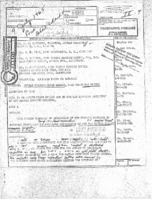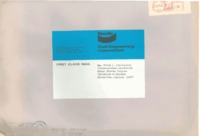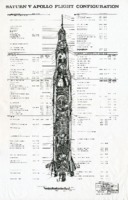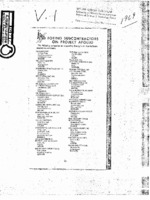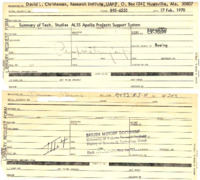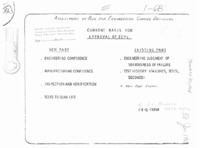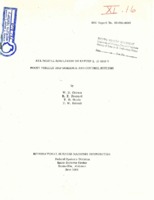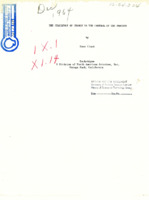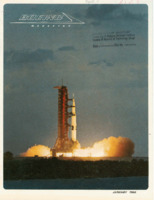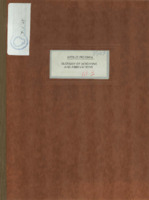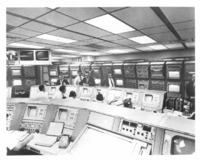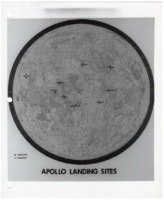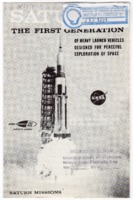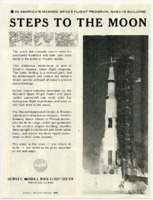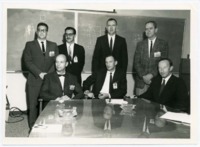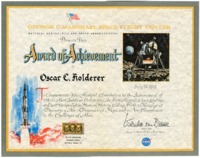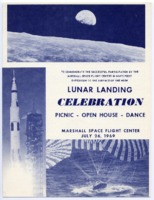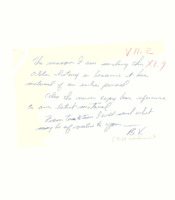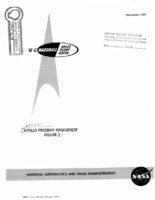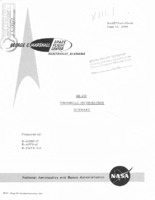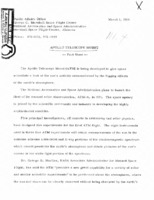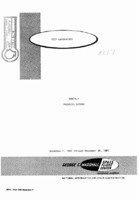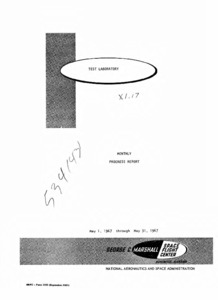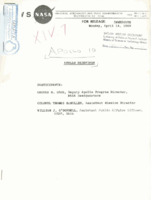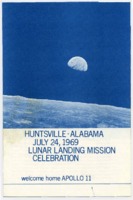
Browse Items (204 total)
Sort by:
-
Telegraphic message containing an Apollo Program Flash Report.
This message for the Apollo Program Director contains a report of the Apollo launch vehicles, problem that occurred, and actions required. The photocopy is difficult to read. -
"Saturn V Apollo Flight Configuration."
Drawn by Don Sprague at the Huntsville Engineering section of Boeing. -
Boeing Subcontractors on Project Apollo.
The document is a list of Boeing subcontractors on Project Apollo including contractor locations, projects, and funding. -
"Apollo Logistics Support System (ALSS) Payloads Summary Report."
This report includes a summary of the major tasks performed by the Apollo Logistics Support System Payloads with an emphasis on the Lunar Mobile Laboratory (MOLAB). -
"Assessment of Risk for Engineering Change Decisions."
This document includes the current basis for approval of ECPs, fatigue life after stress reduction, and other probability and comparative risk assessments. On the first page there is an inscription, "By E.L. Bombara NASA-MSFC." -
"All Digital Simulation of Saturn I, IB, and V: Boost Vehicle and Guidance Control Systems."
The introduction notes, "The Saturn V launch vehicle is being developed by the National Aeronautics and Space Administration's George C. Marshall Space Flight Center for Project Apollo; Saturn I and Saturn IB vehicles are providing the early testing and support for Project Apollo. The nerve center of the Saturn is its guidance and control system. An airborne digital computer provides the link which closes both the guidance and control loops,making verification of the flight computer program of vital importance. During a powered flight this onboard digital computer program can be divided into four major parts:a) guidance, including navigation, b) control, c) vehicle sequencing, and d) computer telemetry." -
"The Challenge of Change vs the Control of the Process."
The introduction states, "This paper is designed to present the Rocketdyne engine program as it applies to the Saturn launch vehicles and will apply to the Apollo program of manned flight to the moon (Fig. 1). The vehicle that will launch this flight is the Saturn V, the largest and most powerful of the Saturn family. This vehicle, 362 feet tall and 33 feet in diameter, will be capable of sending a 45-ton payload to the moon or placing a 120-ton payload in earth orbit. Five F-1 engines power the first stage of the Saturn V; five J-2 engines, the second stage; and one J-2 engine, the third stage. The thrust of the first-stage engines alone will be equivalent to 160 million horsepower. Both of these engines, the F-1 and the J-2, were designed at, and are currently being produced by Rocketdyne." -
Boeing Magazine, vol. XXXVIII, no. 1, January 1968.
The magazine includes the articles "'A Pleasure to Our Eyes'", "New Paint Job", "Six-year Gasp", "Wings on the Nose", "How is SRAM Doing", "Flying Carpet", "A Citizen's Debt", and "Investment in Bonds". Also included is a briefing of events in the Boeing Company. -
"Apollo 7 Liftoff, Oct '68."
View from the spectator's gallery at Cape Canaveral as Apollo 7 launches. The film tracks the rocket from when the engines are ignited to when it disappears from view. Fall 1968. -
"Apollo 15 (Apollo 11 or 12?)."
Konrad Dannenberg goes to see one of the later Apollo flights liftoff from Cape Canaveral, Florida. This film contains a lot of shots of the spectator gallery as well as the lauch and disappearance of the Saturn V launching vehicle. 1969. -
"Daytona Beach - Apollo 15 - Traffic Jam."
The Dannenbergs travel down to Daytona Beach, Florida, to see the launch of Apollo 15. The first half shows the resort and Ingeborg sitting by the beach. The second half shows the drive to the launch facility in Cape Canaveral, Florida and the traffic they find upon arrival. 1971. -
"Apollo 15 Launch - Satellite model."
Konrad Dannenberg tours the visitor stand for the launch of Apollo 15. Of paticular note is a scale model the is on display showing a cross-section of the Skylab space station, as well as brief shots of the Saturn V launcher and the Vehicle Assembly Building. 1971. -
Apollo 15 launch footage.
First half of film shows the launch of Apollo 15 from Cape Canaveral. The second half shows three women, one of them Ingeborg Dannenberg, visiting a beach, probably near Cape Canaveral. 1971. -
"Apollo 16 Pre-launch, 4-23-72."
Ingeborg and Konrad get ready for the launch of Apollo 16. They are shown boarding a bus from their hotel in Cape Canaveral, Florida which conveys them to the visitor stands to watch the launch. While on the road to the stands, Konrad captures pictures of the vehicle assembly building and the rocket on the launchpad. Spring 1972. -
"4-23-72, Apollo 16 Launch."
The first half of the film shows Konrad Dannenberg surveying the stands for spectators of Apollo 16 at the launch complex in Cape Canaveral, Florida. The second half of the film follows the rocket as it lifts off from the launch pad and ascends out of view. Spring 1972. -
Skylab.
Wernher von Braun conversing with multiple people on the management of Saturn/Apollo, Skylab, and Shuttle programs. Both sides. -
Space Stations/Platforms/Workshop (U): A Report Bibliography.
The document is an annotated bibliography of reports from Requested by D. L. Christiensen. 2 -
"Apollo Program: Glossary of Acronyms and Abbreviations."
This glossary contains acronyms and abbreviations commonly found in documentation from the Apollo Program. This glossary is meant to be a tool for historians and other researchers. -
Abbreviated timeline of the Apollo 11 mission.
The timeline includes a memorandum from Friedjof A. Speer, manager of the Missions Operations Office, to employees of Marshall Space Flight Center. Speer notes that "astronaut Neil Armstrong is scheduled to be the first man to step onto the moon's surface." The timeline outlines the entire mission from liftoff at 8:32 AM on Wednesday, July 16, 1969 to splashdown at 11:49 AM on Thursday, July 24, 1969. -
Map of completed and proposed Apollo moon landing sites.
The map shows landing locations on the moon's surface, including proposed landing sites of the cancelled Apollo 18 and Apollo 19 missions. This map was created as part of the Lunar Roving Vehicle (LRV) Project. -
Two astronauts driving a test model of the lunar roving vehicle (LRV).
Developed by Marshall Space Flight Center and built by Boeing, the LRV was an electric vehicle used to explore the Moon's surface during the Apollo 15, 16, and 17 missions. -
"Saturn I: The First Generation of Heavy Launch Vehicles Designed for Peaceful Exploration of Space."
The leaflet outlines the history of Saturn launches and gives a physical description of the rocket. The description includes a diagram of each stage; specifications of each stage's thrust, propellants, liftoff weight, and burning time; and engine specifications. -
"Steps to the Moon."
This flier highlights Marshall Space Flight Center's role in the lunar landing and illustrates each step of a successful mission, from liftoff at Kennedy Space Center to splashdown in the Pacific Ocean. -
The Apollo Lunar Surface Drill team at Marshall Space Flight Center.
John Bensko, Jr. is seated in the center of the front row. -
Marshall Space Flight Center "Lunar Landing Celebration" program.
The celebration included an employee picnic, a dance, and an open house. -
Reproduction of "Apollo Interface Control Document Log."
This copy is a reproduction of a document held by the NASA Scientific and Technical Information Facility . -
Publication listing.
The document is a list of tools from the Manufacturing Engineering Laboratory at MSFC. Included in the list are the tool numbers, titles, and stages of development. Prior to the list the document includes a handwritten note from Bill Vardaman. Issue April 1968. Office R-ME-TDP. -
"Apollo Program Management Volume 3."
According to the introduction found on page ii, this document was created to detail the "MSFC segment of the total Apollo Management process and to describe the methodologies and techniques currently being implemented." -
"AS-203 Technical Information Summary."
"This report outlines, through a series of sketches with accompanying text, the general features of the SA-203 Launch Vehicle and information on launch preparation, the launch facility and mission peculiar experiments." -
Saturn I workshop.
The document describes the scheduling, technical, and managerial plans for the Saturn I orbital workshop. -
"Apollo Telescope Mount Fact Sheet."
This fact sheet contains information related to the Apollo Telescope Mount, or ATM, which allows scientists to look at the activity of the sun through the fogging effects of the earth's atmosphere. -
Test laboratory Monthly Progress Report: November 1, 1967 through November 30, 1967.
The report includes the Systems Test Division; Components and Subsystems Division; Technical Support Division; and the Advanced Facilities Planning Office. -
"Test Laboratory monthly progress report : May, 1967."
Progress report for May, 1967. -
Briefing for Apollo 10.
This document contains a transcript of the briefing meeting for the launch of Apollo 10. Participants include George H. Hage, Colonel Thomas McMullen, and William J. O'Donnell. -
"Educational Lift-Off: Dedication 1969."
The program dedicates three new Huntsville schools, each named for a member of the Apollo crew that died in the pad fire of February 21, 1967. This program was included in one of two scrapbooks that Christel and George McCanless made for UAH history professor Frances Roberts in 1969. -
Pamphlet from the Apollo 11 Lunar Landing Mission Celebration in Huntsville, Alabama.
The pamphlet includes biographical information on the three Apollo 11 astronauts as well as Wernher von Braun, then director of Marshall Space Flight Center. The back of the pamphlet congratulates the NASA and aerospace employees in Huntsville "who have made this historic achievement possible."
